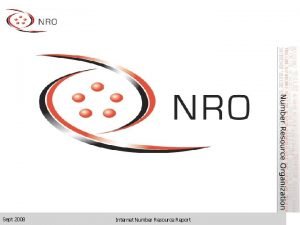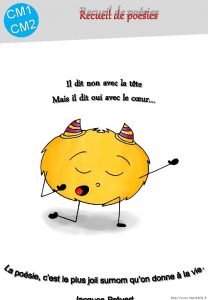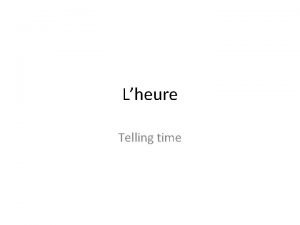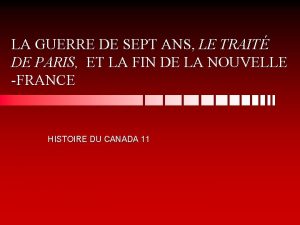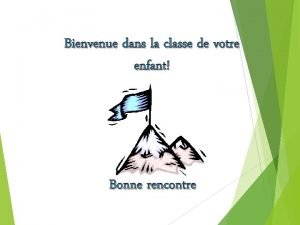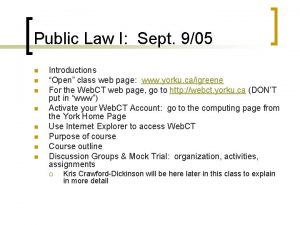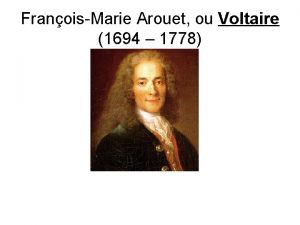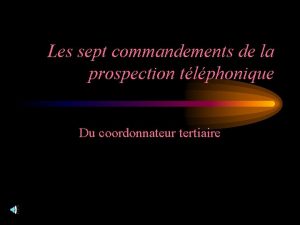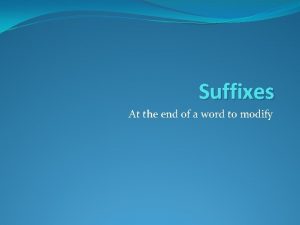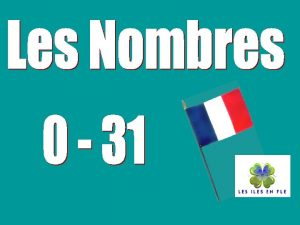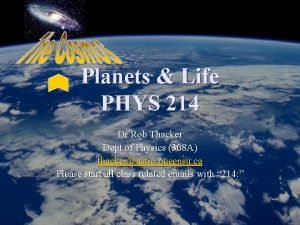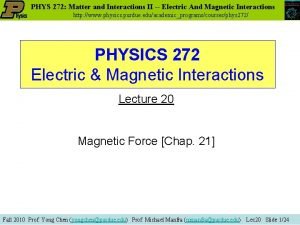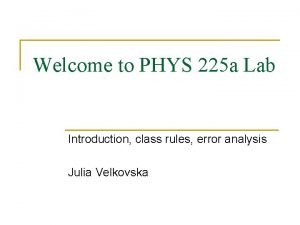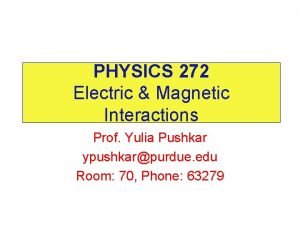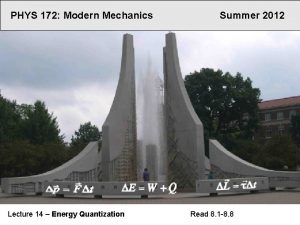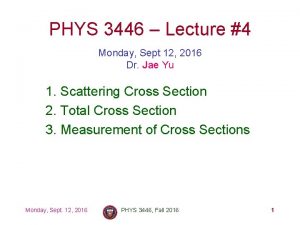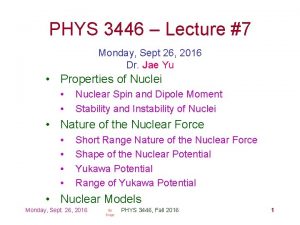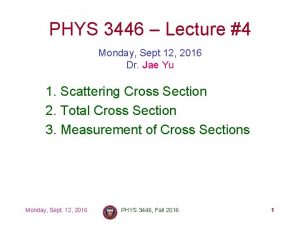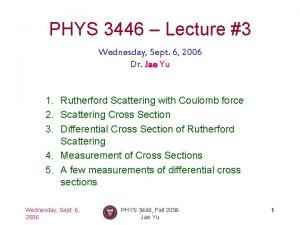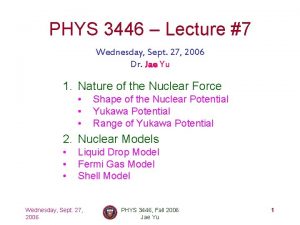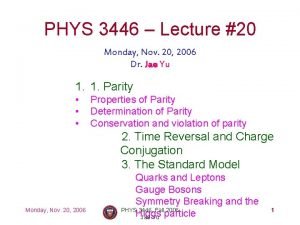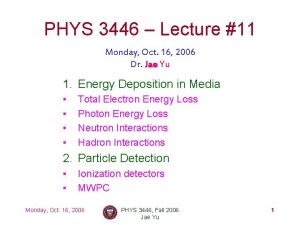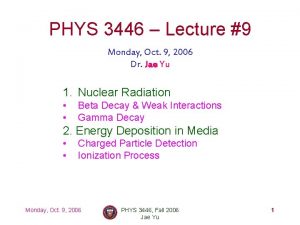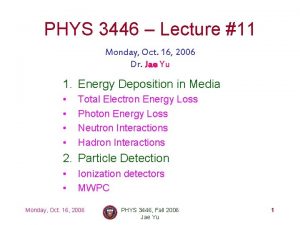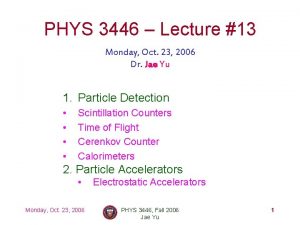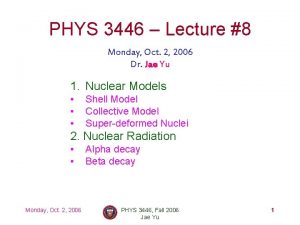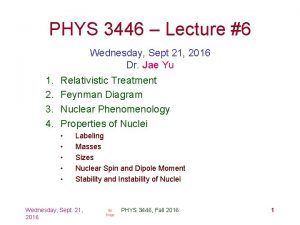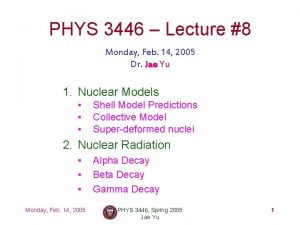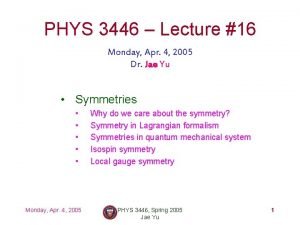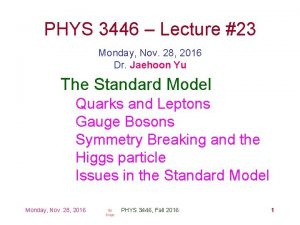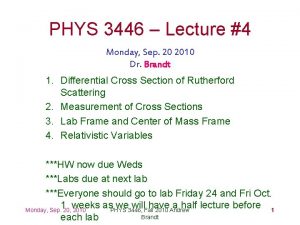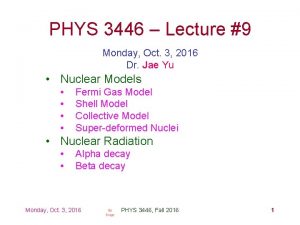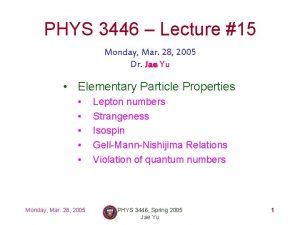PHYS 3446 Lecture 4 Monday Sept 11 2006





















- Slides: 21

PHYS 3446 – Lecture #4 Monday, Sept. 11, 2006 Dr. Jae Yu 1. 2. 3. 4. Lab Frame and Center of Mass Frame Relativistic Treatment Feynman Diagram Invariant kinematic variables Monday, Sept. 11, 2006 PHYS 3446, Fall 2006 Jae Yu 1

Announcements • I now have 9 on the distribution list. – Only three more to go!! Whoopie!! – Please come and check to see if your request has been successful • I will send a test message this week • No lecture this Wednesday but • The class time should be devoted for your project group meetings in preparation for the workshop Monday, Sept. 11, 2006 PHYS 3446, Fall 2006 Jae Yu 2

Scattering Cross Section • For a central potential, measuring the yield as a function of q, or differential cross section, is equivalent to measuring the entire effect of the scattering • So what is the physical meaning of the differential cross section? Þ Measurement of yield as a function of specific experimental variable ÞThis is equivalent to measuring the probability of certain process in a specific kinematic phase space • Cross sections are measured in the unit of barns: Monday, Sept. 11, 2006 PHYS 3446, Fall 2006 Jae Yu 3

Lab Frame and Center of Mass Frame • We assumed that the target nuclei do not move through the collision in Rutherford Scattering • In reality, they recoil as a result of scattering • Sometimes we use two beams of particles for scattering experiments (target is moving) • This situation could be complicated but. . • If the motion can be described in the Center of Mass frame under a central potential, it can Monday, Sept. 11, 2006 PHYS 3446, Fall 2006 4 be simplified Jae Yu

Lab Frame and CM Frame • The equations of motion can be written wher e Since the potential depends only on relative separation of the particles, we redefine new variables, relative coordinates & coordinate of CM an d Monday, Sept. 11, 2006 PHYS 3446, Fall 2006 Jae Yu 5

Lab Frame and CM Frame • From the equations in previous slides Reduce d Mass and Thu Whatsdo we learn from this exercise? • • For a central potential, the motion of the two particles can be decoupled when re-written in terms of – a relative coordinate – The coordinate of center of mass Monday, Sept. 11, 2006 PHYS 3446, Fall 2006 Jae Yu 6

• Now with some simple arithmatics From the equations of motion, we obtain • Since the momentum of the system is conserved: • Rearranging the terms, we obtain Monday, Sept. 11, 2006 PHYS 3446, Fall 2006 Jae Yu 7

Lab Frame and CM Frame • The CM is moving at a constant velocity in the lab frame independent of the form of the central potential • The motion is as if that of a fictitious particle with mass m (the reduced mass) and coordinate r. • In the frame where CM is stationary, the dynamics becomes equivalent to that of a single particle of mass m scattering off of a fixed scattering center. • Frequently we define the Center of Mass 8 Monday, Sept. 11, 2006 PHYS 3446, Fall 2006 Jae Yu

Relationship of variables in Lab and CMS • The speed of CM is • Speeds of the particles in CMS are and • The momenta of the two particles are equal and Monday, Sept. 11, 2006 PHYS 3446, Fall 2006 9 opposite!! Jae Yu

Scattering angles in Lab and CMS • q. CM represents the changes in the direction of the relative position vector r as a result of the collision in CMS • Thus, it must be identical to the scattering angle for the particle with the reduced mass, m. • Z components of the velocities of particle with m 1 in lab and CMS are: • The perpendicular components of the velocities are: • Thus, the angles are related, for elastic scattering Monday, Sept. 11, 2006 PHYS 3446, Fall 2006 10 only, as: Jae Yu

• Differential cross sections in Lab and CMS The particles that scatter in lab at an angle q Lab into solid angle d. WLab scatter at q. CM into solid angle d. WCM in CM. • Since f is invariant, df. Lab = df. CM. – Why? – f is perpendicular to the direction of boost, thus is invariant. • Thus, the differential cross section becomes: reorganize Using Eq. 1. 53 Monday, Sept. 11, 2006 PHYS 3446, Fall 2006 Jae Yu 11

• Some Quantities in Special Relativity Fractional velocity • Lorentz g factor • Relative momentum and the total energy of the particle moving at a velocity is • Square of four momentum P=(E, pc), rest mass E 2006 Monday, Sept. 11, PHYS 3446, Fall 2006 12 Jae Yu

Relativistic Variables • Velocity of CM in the scattering of two particles with rest mass m 1 and m 2 is: • If m 1 is the mass of the projectile and m 2 is that of the target, for a fixed target we obtain Monday, Sept. 11, 2006 PHYS 3446, Fall 2006 Jae Yu 13

Relativistic Variables • At very low energies where m 1 c 2>>P 1 c, the velocity reduces to: • At very high energies where m 1 c 2<<P 1 c and m 2 c 2<<P 1 c , the velocity can be written as: Monday, Sept. 11, 2006 PHYS 3446, Fall 2006 Jae Yu Expansion 14

Relativistic Variables • For high energies, if m 1~m 2, • g. CM becomes: • And • Thus g. CM becomes Monday, Sept. 11, 2006 PHYS 3446, Fall 2006 Jae Yu Invarian t 15 Scalar:

Relativistic Variables • The invariant scalar, s, is defined as: • So what is the CMS frame? 0 • Thus, represents the total available energy in the CMS Monday, Sept. 11, 2006 PHYS 3446, Fall 2006 Jae Yu 16

• Useful Invariant Scalar Another invariant. Variables scalar, t, the momentum transfer (differences in four momenta), is useful for scattering: • Since momentum and total energy are conserved in all collisions, t can be expressed in terms of target variables • In CMS frame for an elastic scattering, where Pi. CM=Pf. CM=PCM and Ei. CM=Ef. CM: Monday, Sept. 11, 2006 PHYS 3446, Fall 2006 Jae Yu 17

Feynman Diagram • The variable t is always negative for an elastic scattering • The variable t could be viewed as the square of the invariant mass of a particle with and exchanged in the scattering tchannel diagram Time Momentum of the carrier is the difference between the two particles. • While the virtual particle cannot be detected in the scattering, the consequence of its exchange can be calculated and observed!!! 3446, Fall whose 2006 – A virtual particle is PHYS a particle mass is different 18 Jae Yu than the rest mass Monday, Sept. 11, 2006

Useful Invariant Scalar Variables For convenience we define a variable q 2, • • In the lab frame, , thus we obtain: • In the non-relativistic limit: • q 2 represents “hardness of the collision”. Small q. CM corresponds to small q 2. Monday, Sept. 11, 2006 PHYS 3446, Fall 2006 Jae Yu 19

Relativistic Scattering Angles in Lab and CMS • For a relativistic scattering, the relationship between the scattering angles in Lab and CMS is: • For Rutherford scattering (m=m 1<<m 2, v~v 0<<c): Resulting in a cross section • Divergence at q 2~0, a characteristics of a Coulomb field Monday, Sept. 11, 2006 PHYS 3446, Fall 2006 Jae Yu 20

Assignments 1. Extension of previous w/ the following (due 9/18): 1. Plot the differential cross section of the Rutherford scattering as a function of the scattering angle q with some sensible lower limit of the angle + express your opinion on the sensibility of the cross section, along with good physical reasons 2. Derive Eq. 1. 55 starting from 1. 48 and 1. 49 3. Derive the formulae for the available CMS energy ( ) for • • Fixed target experiment with masses m 1 and m 2 with incoming energy E 1. Collider experiment with masses m 1 and m 2 with incoming energies E 1 and E 2. 4. Reading assignment: Section 1. 7 5. End of chapter problem 1. 7 Monday, Sept. 11, 2006 PHYS 3446, Fall 2006 21 • These assignments are Jae Yu due next Wednesday,
 Phys 241 lecture quizzes
Phys 241 lecture quizzes 01:640:244 lecture notes - lecture 15: plat, idah, farad
01:640:244 lecture notes - lecture 15: plat, idah, farad Sept
Sept Poésie le cowboy et les voleurs
Poésie le cowboy et les voleurs Sept heure moins le quart
Sept heure moins le quart Deportes
Deportes Sept comme setteur questionnaire
Sept comme setteur questionnaire I sept
I sept Ecrivez les sept jours de la semaine
Ecrivez les sept jours de la semaine Damon poole
Damon poole La guerre de sept ans
La guerre de sept ans Sept commandements
Sept commandements Sept prefix words
Sept prefix words Les sept collines de jérusalem
Les sept collines de jérusalem Cnn10 september 7
Cnn10 september 7 Zero un deux trois quatre
Zero un deux trois quatre Phys 214
Phys 214 Phys 272 purdue
Phys 272 purdue Phys 225
Phys 225 Coloumb units
Coloumb units Phys courses ucsd
Phys courses ucsd Phys 172
Phys 172


